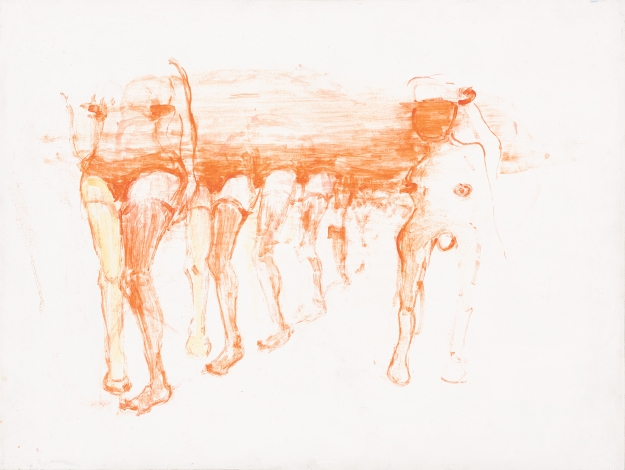Realistic dream-like feelings
I would like to see this interpretation of Alina Melnikova’s (b. 1983) work (Non-)Matching Sizes in a magazine or internet portal for women next to other articles advising how to lose weight, hide imperfections or put your make-up on to make your face look symmetrical and fresh. The work should be presented in a context claiming that you are ugly, lopsided and no good, and that most probably the most important thing in the world is to be beautiful. And I will disagree with all those who wish to label this text as naturalistic reactivism, because there is nothing weird in wanting to be beautiful, but isn’t thrusting products into consumers’ hands blurring the understanding of where beauty stems from? What about the beautiful relationship with myself? What about the beautiful relationship between people in general? Will they only be possible when I am beautiful? Beauty is just as complicated an issue as the question ‘What came first: the chicken or the egg?’, because good manners and attitudes will not help, when such secretive things as DNA come into play.
UždarytiIn her work (Non)Matching Sizes the artist depicts women who seem feel more rather than look well. The physical nature of their bodies is palpable through their imperfections: heavy joints and discommodity experienced when standing veered to one side, pronounced breasts and crotch (they seem to be reacting to natural senses), and bare skin like a screen reacting to cold and warmth.
In this environment, heavily drenched with senses, one may discern two different positions: there is a group of women who all look alike (or there is one vibrant woman accompanied by a multiple echo of her own shapes) and a shorter girl-like female. The latter is two heads shorter than the tall woman. We are looking at the picture from the shorter girl’s perspective, therefore we do not see the head of the taller one. We may presume that the shorter girl is the author’s alter egoor the narrator. We should try to understand her feelings and identify with her wretched situation.
Being shorter than the rest, more lopsided than the dominant (and most probably beautiful) ones, she augments her bodily feelings with additional psychological unpleasantness. She does not fit in the line with others. The proportions of figures radiate a familiar childish disappointment with being the odd one. The title of the work (Non)Matching Sizesendorses this feeling. The ocean of articles for women full of various advice swishes in the background, but it remains unclear whether it has a comforting or a drowning effect. If somebody asked what this piece of artwork is strictly about, I would promptly reply that it is about rejection. However, it also shows a few more things about the artist herself.
Melnikova is capable of being painfully ironic, to the point and portrays unrealistically realistic feelings. For that purpose she pairs several different artistic genres in a very interesting manner.
Melnikova is capable of being painfully ironic, to the point and portrays unrealistically realistic feelings. For that purpose she pairs several different artistic genres in a very interesting manner. Time and again the viewer finds themselves in a strangely realistic dream, because many of the artist’s works are a portrait, a landscape and a still life all at the same time. It is a portrait, because it portrays a human being. However, it is also a landscape, because in Melnikova’s artwork a body turns into an entire landscape, a site of action. At the same time it is a still life, too, because the feelings and sensations of the object and the subject are very much thing-like and clearly tactile. Melnikova’s artistic technique trespasses several boundaries, too. Her paintings look like watercolours or drawings, or even body (blood) prints.
Melnikova’s artwork can be divided into three groups: the sensitive group, which openly and boldly displays personal feelings and vulnerability (mostly paintings); the phallic group (video works and stencils), where the artist substitutes unpleasant situations with fantasised ones; and the combination of the first two, where paintings are not personal anymore, but rather excite the senses and are more manipulative than intruding into the ‘soft’parts of the body.
The artist’s work (Non)Matching Sizes belongs to the first group of her artwork, where her paintings have a skin-like surface. Her works embarrass like a naked body (inconvenient/erotic/in disagreement with ideals), but still feel very homely. Her pale canvases feel like they were raw and blasted themselves, and thus capable of intensively affecting time and again. The motifs of Melnikova’s paintings are heavily impregnated with ghostly images from the history of art, religion, television, glossy press and internet.
Her characters do not represent the theoretical me, but rather the actual inhabitant of the quagmire who sometimes does not know whom to believe or how to feel.
Her characters do not represent the theoretical me, but rather the actual inhabitant of the quagmire who sometimes does not know whom to believe or how to feel. It is so beautiful to see that in her artwork Melnikova actually experiences all the unpleasant feelings in a deep, bold and virtual manner. Even though many of her works include some infantile details (such as a princess crown), they radiate maturity.



